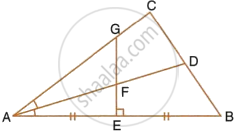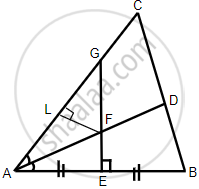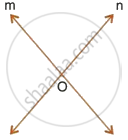Advertisements
Advertisements
प्रश्न
The given figure shows a triangle ABC in which AD bisects angle BAC. EG is perpendicular bisector of side AB which intersects AD at point F.
Prove that:

F is equidistant from AB and AC.
उत्तर

Construction: Draw LF ⊥ AC
Proof: In ΔAFL and ΔAFE,
∠FEA = ∠FLA ...(Each = 90°)
∠LAF = FAE ...(AD bisects ∠BAC)
AF = AF ...(Common)
∴ By angle – Angle side criterion of congruence,
ΔAFL ≅ AFE ...(AAS postulate)
The corresponding parts of the congruent triangles are congruent.
∴ FE = FL ...(C.P.C.T.)
Hence, F is equidistant from AB and AC.
APPEARS IN
संबंधित प्रश्न
Draw a line AB = 6 cm. Draw the locus of all the points which are equidistant from A and B.
Draw an ∠ABC = 60°, having AB = 4.6 cm and BC = 5 cm. Find a point P equidistant from AB and BC; and also equidistant from A and B.
Describe the locus of points at a distance 2 cm from a fixed line.
Describe the locus of the moving end of the minute hand of a clock.
Describe the locus of the centres of all circles passing through two fixed points.
Describe the locus of points at distances less than or equal to 2.5 cm from a given point.
In the given figure, obtain all the points equidistant from lines m and n; and 2.5 cm from O.

In a quadrilateral ABCD, if the perpendicular bisectors of AB and AD meet at P, then prove that BP = DP.
ΔPBC and ΔQBC are two isosceles triangles on the same base BC but on the opposite sides of line BC. Show that PQ bisects BC at right angles.
Given: ∠BAC, a line intersects the arms of ∠BAC in P and Q. How will you locate a point on line segment PQ, which is equidistant from AB and AC? Does such a point always exist?
